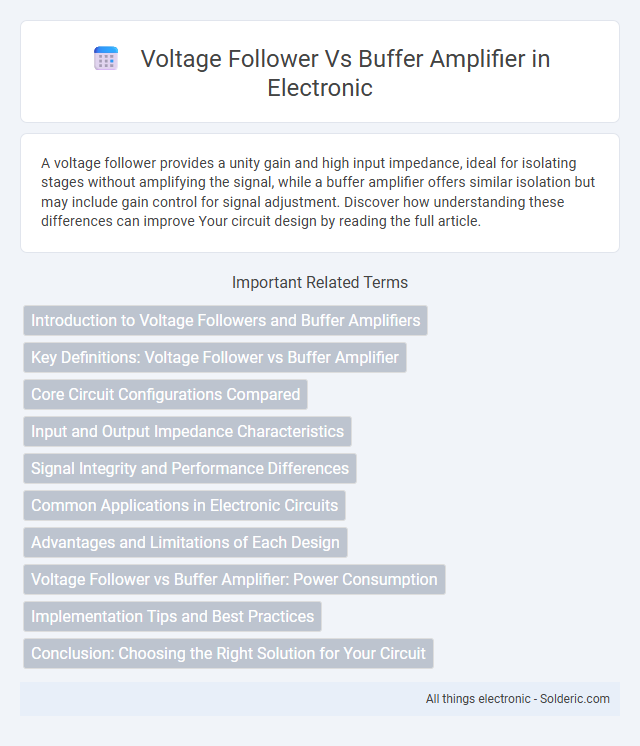A voltage follower provides a unity gain and high input impedance, ideal for isolating stages without amplifying the signal, while a buffer amplifier offers similar isolation but may include gain control for signal adjustment. Discover how understanding these differences can improve Your circuit design by reading the full article.
Comparison Table
| Feature | Voltage Follower | Buffer Amplifier |
|---|---|---|
| Definition | Op-amp circuit with unity gain (gain = 1) output voltage equals input voltage | Amplifier designed to provide impedance matching without voltage gain |
| Voltage Gain | Unity (1) | Unity or very close to unity (1) |
| Input Impedance | Very High (typically megaohms to gigaohms) | High, designed to prevent signal loading |
| Output Impedance | Very Low (tens of ohms or less) | Low, suitable for driving low impedance loads |
| Purpose | Signal isolation and buffering to maintain voltage level | Impedance matching and drive capability enhancement |
| Common Applications | Sensor interfacing, analog signal buffering | Driving heavy loads, impedance transformation circuits |
| Stability | Highly stable due to unity gain configuration | Stable, but depends on amplifier design and feedback |
Introduction to Voltage Followers and Buffer Amplifiers
Voltage followers and buffer amplifiers serve to isolate different circuit stages by providing high input impedance and low output impedance, ensuring signal integrity without loading the source. A voltage follower replicates the input voltage at its output with unity gain, ideal for impedance matching in analog circuits. Buffer amplifiers extend this concept by offering similar isolation while sometimes providing gain or additional functionality based on design requirements.
Key Definitions: Voltage Follower vs Buffer Amplifier
A voltage follower is an operational amplifier configuration where the output voltage directly tracks the input voltage, providing unity gain and high input impedance. A buffer amplifier serves as an impedance matching device, isolating the input source from the load and preventing signal degradation while maintaining voltage levels. Both devices deliver high input impedance and low output impedance, but the voltage follower specifically emphasizes signal replication without amplification gain.
Core Circuit Configurations Compared
Voltage followers and buffer amplifiers both utilize op-amp configurations but differ in function and circuit design. A voltage follower employs a unity gain (gain = 1) configuration where the output directly connects to the inverting input, providing high input impedance and low output impedance without voltage amplification. Buffer amplifiers typically use similar configurations but may incorporate impedance matching components to isolate load effects, ensuring signal integrity in your electronic circuits.
Input and Output Impedance Characteristics
Voltage followers exhibit very high input impedance, often in the megaohms range, preventing loading on the preceding stage. Buffer amplifiers typically offer low output impedance, ensuring stable voltage delivery to subsequent components without significant signal loss. Your circuit benefits from these impedance characteristics by maintaining signal integrity between stages.
Signal Integrity and Performance Differences
A voltage follower provides unity gain with high input impedance and low output impedance, preserving signal integrity by preventing loading effects and minimizing distortion. Buffer amplifiers, while similar, often include gain stages that can improve drive capabilities and bandwidth but may introduce slight noise and phase shifts impacting signal fidelity. The choice depends on application requirements where voltage followers excel in precise signal replication and buffer amplifiers offer enhanced drive strength with minimal performance trade-offs.
Common Applications in Electronic Circuits
Voltage followers are commonly used in signal conditioning to provide high input impedance and low output impedance, ensuring that sensor signals are transmitted without loading effects. Buffer amplifiers serve critical roles in impedance matching between different circuit stages, maintaining signal integrity in audio, data acquisition, and communication systems. Both components are essential in preventing signal degradation and stabilizing voltage levels across analog circuit designs.
Advantages and Limitations of Each Design
Voltage followers provide high input impedance and low output impedance, ideal for impedance matching without signal gain, ensuring signal integrity in sensitive circuits. Buffer amplifiers offer the advantage of signal amplification with minimal distortion and can drive heavier loads, but may introduce slight voltage offset and consume more power. Your choice depends on whether signal buffering or signal amplification with load-driving capability is the priority, balancing overall circuit performance and power efficiency.
Voltage Follower vs Buffer Amplifier: Power Consumption
A voltage follower typically exhibits low power consumption due to its simple configuration, providing unity gain without amplifying the signal power. Buffer amplifiers, while designed to isolate and drive loads effectively, may consume slightly more power as they handle higher current loads to maintain signal integrity. Your choice between the two depends on balancing the need for minimal power usage against the required drive capability in your circuit.
Implementation Tips and Best Practices
Use an operational amplifier with a unity gain configuration for both voltage followers and buffer amplifiers to achieve high input impedance and low output impedance. Ensure proper power supply decoupling and minimize feedback loop length to reduce noise and oscillations. Select precision op-amps with low offset voltage for accurate signal buffering in sensitive analog circuits.
Conclusion: Choosing the Right Solution for Your Circuit
Voltage followers provide unity gain and high input impedance, ideal for impedance matching without signal amplification. Buffer amplifiers offer gain control and improved drive capability for signals requiring amplification and stabilization. Selecting between them depends on whether your circuit prioritizes signal isolation without gain or requires signal strength enhancement alongside impedance buffering.
voltage follower vs buffer amplifier Infographic

 solderic.com
solderic.com